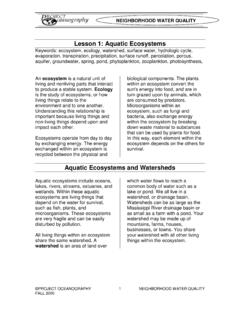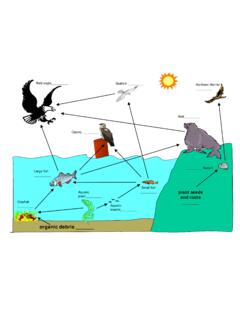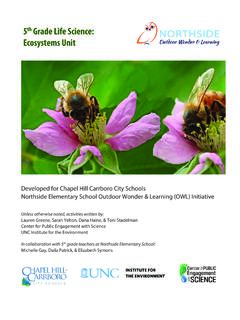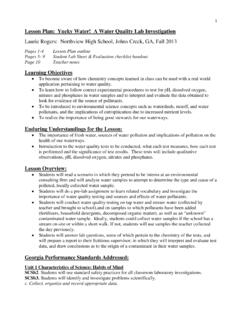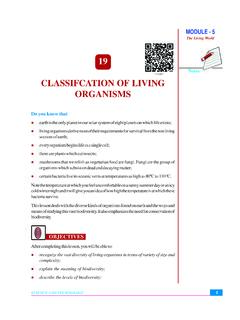Transcription of Biomes - BIOLOGY
1 BiomesSay Thanks to the AuthorsClick (No sign in required)To access a customizable version of this book, as well as otherinteractive content, visit Foundation is a non-profit organization with a mission toreduce the cost of textbook materials for the K-12 market both inthe and worldwide. Using an open-source, collaborative, andweb-based compilation model, CK-12 pioneers and promotes thecreation and distribution of high-quality, adaptive online textbooksthat can be mixed, modified and printed ( , the FlexBook textbooks).Copyright 2016 CK-12 Foundation, names CK-12 and CK12 and associated logos and theterms FlexBook and FlexBook Platform (collectively CK-12 Marks ) are trademarks and service marks of CK-12 Foundation and are protected by federal, state, and form of reproduction of this book in any format or medium,in whole or in sections must include the referral attribution (placed in a visible location) inaddition to the following as otherwise noted, all CK-12 Content (including CK-12 Curriculum Material) is made available to Users in accordancewith the Creative Commons Attribution-Non-Commercial (CC BY-NC ) License ( ), as amended and updated by Creative Com-mons from time to time (the CC License ), which is incorporatedherein by this terms can be found at : January 21, 1.
2 BiomesCHAPTER1 BiomesLesson Objectives Identify and describe terrestrial Biomes . Give an overview of aquatic aphotic zone aquatic biome climate dormancy estuary freshwater biome growing season intertidal zone marine biome photic zone phytoplankton terrestrial biome wetland zooplanktonIntroductionIf you look at the two pictures , you will see very few similarities. The picture on the left shows adesert in Africa. The picture on the right shows a rainforest in Australia. The desert doesn t have any visible plants,whereas the rainforest is densely packed with trees. What explains these differences?FIGURE Desert in northern Africa (left).RainforestinnortheasternAustralia (right).Two very different Biomes arepictured here. Both are found at roughlythe same distance from the two pictures represent two different Biomes . A biome is a group of similar ecosystems with thesame general abiotic factors and primary producers.
3 Biomes may be terrestrial or BiomesTerrestrial biomesinclude all the land areas on Earth where organisms live. The distinguishing features of terrestrialbiomes are determined mainly by climate. Terrestrial Biomes include tundras, temperate forests and grasslands,chaparral, temperate and tropical deserts, and tropical forests and Biomes and ClimateClimateis the average weather in an area over a long period of time. Weather refers to the conditions of theatmosphere from day to day. Climate is generally described in terms of temperature and falls from the equator to the poles. Therefore, major temperature zones are based on latitude. Theyinclude tropical, temperate, and arctic zones ( ). However, other factors besides latitude may alsoinfluence temperature. For example, land near the ocean may have cooler summers and warmer winters than landfarther inland. This is because water gains and loses heat more slowly than does land, and the water temperatureinfluences the temperature on the coast.
4 Temperature also falls from lower to higher altitudes. That s why tropicalzone mountain tops may be capped with Zones. Temperature zonesare based on latitude. What temperaturezone do you live in?In terms of moisture, climates can be classified as arid (dry), semi-arid, humid (wet), or semi-humid. The amount ofmoisture depends on both precipitation and and Plant GrowthPlants are the major producers in terrestrial Biomes . They have five basic needs: air, warmth, sunlight, water, andnutrients. How well these needs are met in a given location depends on the growing season and soil quality, both ofwhich are determined mainly by 1. Biomes Thegrowing seasonis the period of time each year when it is warm and wet enough for plants to grow. Thegrowing season may last all year in a hot, wet climate but just a few months in a cooler or drier climate. Plants grow best in soil that contains plenty of nutrients and organic matter.
5 Both are added to soil when plantlitter and dead organisms decompose. Decomposition occurs too slowly in cold climates and too quickly inhot, wet climates for nutrients and organic matter to accumulate. Temperate climates usually have the bestsoil for plant and BiodiversityBecause climate determines plant growth, it also influences the number and variety of other organisms in a terrestrialbiome. Biodiversity generally increases from the poles to the equator. It is also usually greater in more humidclimates. This is apparent from the desert and rainforest Biomes pictured and AdaptationsOrganisms evolve adaptations that help them survive in the climate of the biome where they live. For example, inbiomes with arid climates, plants may have special tissues for storing water ( ). The desert animalspictured also have adaptations for a dry Plant and Barrel Cactus. The aloeplant on the left stores water in its large,hollow leaves.
6 The cactus plant on theright stores water in its stout, barrel-shaped Monster and Kangaroo Rat. The Gilamonster s fat tail is an adaptation to itsdry climate. It serves as a storage depotfor water. The kangaroo rat has very effi-cient kidneys. They produce concentratedurine, thus reducing the amount of waterlost from the Biomes with cold climates, plants may adapt by becoming dormant during the coldest part of the a state in which a plant slows down cellular activities and may shed its leaves. Animals also adapt to One way is with insulation in the form of fur and fat. This is how the polar bears Bears. Thick fur and a layer of blub-ber keep polar bears warm in their Arcticecosystem. Why do you think their fur iswhite? Why might it be an adaptation inan Arctic biome?Survey of Terrestrial BiomesTerrestrial Biomes are classified by climatic factors and types of primary producers.
7 The world map where 13 major terrestrial Biomes are following figures summarize the basic features of major terrestrial Biomes . Think about how its biodiversity andtypes of plants and animals relate to its climate. For example, why do you think there are no amphibians or reptilesin tundra Biomes ? (Hint: Amphibians and reptiles cannot maintain a constant body temperature. Instead, they haveabout the same temperature as their surroundings.) 1. BiomesFIGURE Distribution of Terrestrial Biomes . This map shows the locations of Earth s major terrestrial 1. BiomesAquatic BiomesTerrestrial organisms are generally limited by temperature and moisture. Therefore, terrestrial Biomes are defined interms of these abiotic factors. Most aquatic organisms do not have to deal with extremes of temperature or , their main limiting factors are the availability of sunlight and the concentration of dissolved oxygen andnutrients in the water. These factors vary from place to place in a body of water and are used to Biomes and SunlightIn large bodies of standing water, including the ocean and lakes, the water can be divided into zones based on theamount of sunlight it receives:1.
8 Thephotic zoneextends to a maximum depth of 200 meters (656 feet) below the surface of the water. This iswhere enough sunlight penetrates for photosynthesis to occur. Algae and other photosynthetic organisms canmake food and support food Theaphotic zoneis water deeper than 200 meters. This is where too little sunlight penetrates for photo-synthesis to occur. As a result, food must be made by chemosynthesis or else drift down from the and other aquatic zones in the ocean are identified Biomes and Dissolved SubstancesWater in lakes and the ocean also varies in the amount of dissolved oxygen and nutrients it ocean is divided into many different zones, depending on distance from shore and depth of Water near the surface of lakes and the ocean usually has more dissolved oxygen than does deeper water. Thisis because surface water absorbs oxygen from the air above Water near shore generally has more dissolved nutrients than water farther from shore.
9 This is because mostnutrients enter the water from land. They are carried by runoff, streams, and rivers that empty into a body Water near the bottom of lakes and the ocean may contain more nutrients than water closer to the aquatic organisms die, they sink to the bottom. Decomposers near the bottom of the water break downthe dead organisms and release their nutrients back into the OrganismsAquatic organisms generally fall into three broad groups: plankton, nekton, and benthos. They vary in how theymove and where they Plankton are tiny aquatic organisms that cannot move on their own. They live in the photic zone. Theyinclude phytoplankton and bacteria and algae that use sunlight to tiny animals that feed on Nekton are aquatic animals that can move on their own by swimming through the water. They may 1. Biomesin the photic or aphotic zone. They feed on plankton or other nekton. Examples of nekton include fish Benthos are aquatic organisms that crawl in sediments at the bottom of a body of water.
10 Many are decom-posers. Benthos include sponges, clams, and anglerfish like the one How has this fish adaptedto a life in the dark?FIGURE This anglerfish lives between 1000 and 4000 meters belowsea level. No sunlight penetrates to this depth. The rod-like structure onits face has a glow-in-the-dark tip. It is covered with microorganisms thatgive off their own light. The fish wiggles the structure like a worm to attractprey. In the darkness, only the rod-like worm is BiomesAnglerfish live in the ocean. aquatic Biomes in the ocean are calledmarine Biomes . Organisms that live in marinebiomes must be adapted to the salt in the water. For example, many have organs for excreting excess salt. Two oceanzones are particularly challenging to marine organisms: the intertidal zone and the deep zoneis the narrow strip along the coastline that is covered by water at high tide and exposed to airat low tide ( ). There are plenty of nutrients and sunlight in the intertidal zone.
